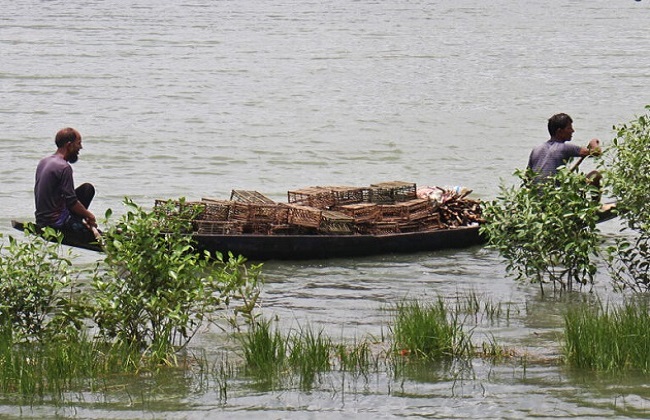
Abdus Sobur is a small fisherman with a simple formula for success: “Catch those mud crabs, both male and female, and sell them to the local dealer at a high price.”
Sobur’s fishing grounds are Bangladesh’s Sundarbans, the world’s largest mangrove forest, where he catches 40-50 kilograms (88-110 pounds) of crabs daily, year-round.
The dealers he sells to are people like Khisnopodo Shaha, who in turn usually ships about 3-4 metric tons of crabs daily to exporters in Dhaka. Of this figure, Shaha buys the vast majority from mangrove crabbers like Sobur, and only about 5% from fishers who cultivate crabs on aquafarms.
That massive imbalance, echoing up the supply chain, has prompted alarm among experts and conservationists who say that Bangladesh may be overexploiting its wild crab stocks.
If crab-harvesting rates from the wild continue at current rates, says Shafiqul Islam, a professor of marine science at the University of Chittagong, then “the crab becomes endangered. Artificial reproductive techniques should be introduced for crabs rather than catching them from the wild. Otherwise, the natural stock of crab will be imbalance[d].”
The same problem was flagged in a 2020 study that found mud crabs (Scylla spp.) are being overfished from the Sundarbans, resulting in severe impacts to the genetic diversity of the remaining population. It also says the depletion of wild mud crabs may lead to ecosystem imbalances resulting in deterioration of water and soil, along with loss of biodiversity in the Sundarbans mangroves and other areas experiencing high fishing pressure.
The Bangladesh government bans crab catching in the Sundarbans in January and February, which is when the crustaceans breed. The three months from June through August are also closed to any kind of activity in the Sundarbans, aimed at allowing the world’s most extensive mangrove forests to recover. But these restrictions are seldom enforced, with fishers like Sobur saying he fishes there throughout the year.
“We are always alert of this matter,” says Mihir Kumar, the regional forest conservator for the Bangladesh Forest Department. “If any fishermen or mawali [honey collectors] catch them from nature, we arrest them, file lawsuits, and penalize them. It is a continuous process; we do raid those concerned areas regularly to stop any illegal activities.”
However, Kumar says ending the illegal harvesting outright will always be challenging.
A big reason is just how lucrative the crab trade is, both at the local level and for the national economy. According to the Bangladesh Export Promotion Bureau, the country exported about $35 million worth of crabs in the 2019-2020 fiscal year. The figure includes both hard-shell and soft-shell crabs.
The primary market for hard shell-crabs, which are exported live, is China. For soft-shell crabs — essentially the same species harvested while molting, and therefore not yet having had time to develop a new hard carapace — the main markets are the U.S., Australia, the U.K., the EU and Singapore. Soft-shell crab exports in particular are on the rise.
The alternative to harvesting crabs from the wild is to raise them in aquafarms. In Satkhira district, where Sobur operates, some 3,000 people are involved in crab farming, according to the local office of the Department of Fisheries. These aquafarms cover a total area of 321 hectares (793 acres), yielding about 2,000 metric tons of crabs annually from this district alone.
Fisheries stakeholders say that if this sector is given due importance and its problems addressed, it could significantly boost earnings from crab exports.
But scaling up crab cultivation has proved difficult. The practice at present involves catching crabs from the wild, often in their juvenile stage, and then raising and fattening them in aquafarm enclosures. Once they’ve grown sufficiently large, the crabs can be sold. As such, the aquafarms are just as reliant on adequate wild crab stocks as are crabbers like Sobur.
A more sustainable form of crab cultivation would be to hatch the crabs from eggs on aquafarms. There are various initiatives underway by the government and the private sector to do this, in an effort to reduce dependence on wild stocks, says Satkhira district fisheries officer Anishur Rahman. But none of these has reached the stage where it can be commercially scaled up. For now, then, the country’s crab fishery remains reliant on nature, Rahman says.
(This article was republished from Mongabay under Creative Commons License)
Farhana Parvin is a free-lance journalist based in Dhaka, Bangladesh

